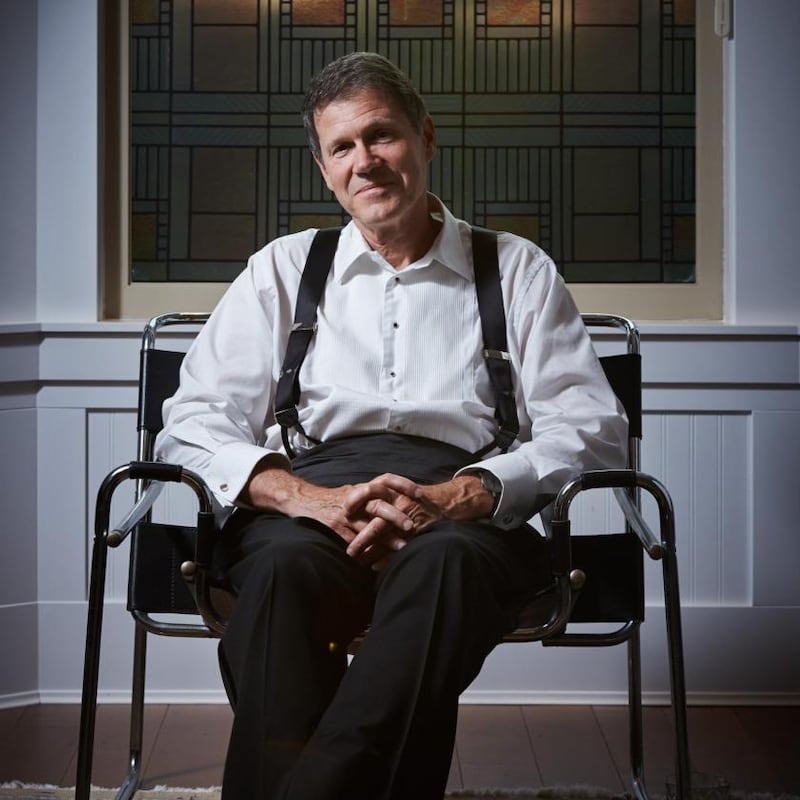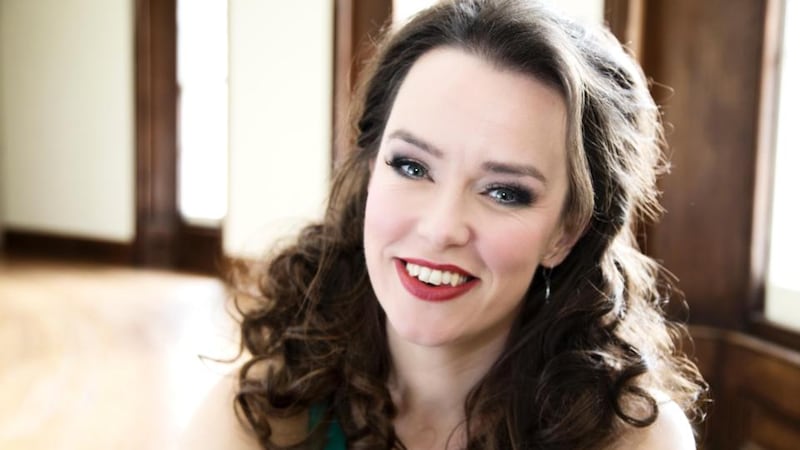What is it about opera and divas? Soprano, Susannah Biller's first brush with the art form, involved her beating up a tenor backstage. In fairness, she was only three years old at the time. "My aunt was an opera singer," remembers Biller, when we meet in Wexford as she gets ready to rehearse her role as Kitty Packard in the European premiere of William Bolcom's Dinner at Eight. "She was doing Carmen in Cincinnati. Jerry Hadley was playing José. It was a more modern interpretation, and I didn't really understand it. And my Mom didn't think to tell me she dies in the end.
“Yah,” she says, her green blue eyes bright with amusement as she unfolds her tale. “Big mistake. He doesn’t just stab her once, it’s like multiple times. And I just started screaming, from the top tier. So Mom had to take me out. We go back stage, I’m inconsolable. Jerry Hadley comes out, covered in blood, and I just start hitting him as hard as I possibly could. Diva is definitely a stretch,” concludes Biller. “I’m from Tennessee, so I definitely mow my own lawn. But that was different; he killed my aunt.”
Opera is a business where people's emotions are high. Theatre is a pastoral field compared to the opera house
Irish mezzo soprano, Sharon Carty, who will be playing the more restrained character of Lucy Talbot, joins us. "Holy crap," she says when we update her on the conversation, before confirming that she herself has never beaten anyone up in the theatre. "I may have wanted to, but restrained myself."
“It’s usually verbal,” agrees Biller.
In fact, opera is full of divas, but they're frequently not the ones on the stage. Part of the reason is that of all the art forms, opera is the most total: alongside the soloists and chorus, it also includes orchestra, acting, dancing, technical wizardry, set and costume design. When I arrive at Wexford Opera House, the set for the double bill, L'Oracolo and Mala Vita, is not playing ball. "The revolve is eating the stage wood," says artistic director David Agler, who goes on to confirm that opera is "a business where, as you can imagine, people's emotions are high. Theatre is a pastoral field compared to the opera house."

Agler, who will be stepping down from Wexford next year, after 14 years in the role, says he got into opera by mistake; after a fight between a composer and a conductor left a gap in a programme. He had been planning to become a monk. Are fights so very common, I wonder? “They can be. Singing is a very interesting and complicated art form. When you think about what singers have to do, they have to sing these really demanding roles, which means they have to be an athlete, they have to have a good singing technique, they have to wear all these clothes, they have to be with the orchestra, they have to sing in many languages.”
The audiences are different too. "People who go to the opera, it's almost a blood sport," says Agler, who has a quick wit and a gentle manner, belied by the constant energy and movement in his hands. He will be conducting Dinner at Eight, having been invited by the composer, who is a good friend. I wonder about the role of the conductor, whose job it is to hold it all together, reel it out and pull it in. "I'm known as a cool conductor," he says. "A one-shirt conductor," he affirms, alluding to others who have to change clothes, dripping with sweat in the interval. "Sometimes singers want to go faster. I'm not a shouter, but I'm told by people you can see it, because of the way my jaw sits."
It's hectic at the opera house, as three brand new productions are in rehearsal for Wexford Festival Opera, which won Best Festival at the 2017 International Opera Awards. Designers and directors are trying to share stages and dressing rooms are full of carefully labelled clothes, accessories, hats and shoes. Vita Tzykun, who has created the glorious 1930s costumes for Dinner at Eight comes to show me around. "Opera is dangerous," she says, joining our conversation. "That's why I love it. You don't get that tension in film or video games. Being an opera singer is single handedly one of the most difficult professions in the world, because it's all happening in real time."

The opera house in Minnesota is larger than Wexford, so Tzykun is focusing on the detailing of her costumes, as the audiences will be closer. "In theatre, clothes are storytelling devices," she says, gleefully showing me a pair of truly hideous cufflinks she has found for the character of Dan Packard, the newly-wealthy brash industrialist. Dinner at Eight was originally a Broadway play, before becoming a MGM film starring Jean Harlow and John Barrymore. Set in the Great Depression, it is about manners, the acquisition and use of power, and fortunes made and lost. It has a great deal of relevance today.
“I think a lot about light and movement when I design,” she says, trying on a hat, and swinging round with a smile. The attention to detail is extraordinary. A black and white dress has its hem stiffened with horse hair for shape. A bias-cut green silk dress, that Carty will wear in the final act, is all hand-made couture. We come to Biller’s wardrobe. “She really is a mountain of pink,” says Tzykun, counting 17 layers of flounces in the sleeve puffs of a negligee. “She’s wearing this when she argues with her obnoxious husband; it’s one of my favourites.” Agler believes New York-based Tzykun, who also designs for film, is a genius. “She’ll win an Oscar one day.”
Biller is also a fan of the negligee, though she also describes it as a “concern. You have to be taped in. I think I have usually [she counts them] at least six pieces of tape per breast. Taking it off,” she says, “involves a lot of ‘special words’; words that my mother would be ashamed of.”
The fact that they can create divine music, and have to train like athletes, shouldn't fool you: opera singers are actually brilliant fun
The fact that they can create divine music with nothing more than a highly schooled set of lungs, vocal cords and diaphragm, and that they have to train like athletes, even calculating when they can eat before a performance (no sooner than an hour before), shouldn’t fool you: opera singers are actually brilliant fun.
Some of them even smoke. Back in the 1930s, when Dinner at Eight is set, the famous Russian Bass, Feodor Chaliapin, had a brand of cigarettes named for him. Both Biller and Carty agree how the clothes help create their characters, but they also dig deep to find what might motivate the people they are playing. "When I first got the part," says Carty, of Lucy Talbot, who is married to a philandering doctor, "I thought, Why in God's name would she stay with him? But, for the time it was probably quite courageous, despite the hurt she feels."
“You find something in yourself that makes the emotion honest,” says Biller. “Or you can take it from other people who are close in your life,” she continues, and goes on to tell of a friend who found a video of her husband cheating on her. “He made a video?” Carty and I shriek in unison. “Yes, and she played it. Ahead of a dinner party. I got there, and the video was playing, and I thought, I want to get the f*** out of here. Then everyone starts turning up, and she just turns it off and says ‘Will we go in to dinner?’.”

“I have no words,” says Carty. We ponder this in silence for a moment, before continuing the question of playing characters outside your own experience. Carty talks about the technicalities of changing the emotion range within a piece of music, which is one of the reasons that opera can be so powerful, and so moving: as beyond the words, the music can speak directly to our own emotional core.
Perhaps it's because of all that emotion, and the closeness a cast and crew will achieve during the intense period of rehearsals and the run itself, that there are other hazards on stage: such as fighting an attack of the giggles. Are those times frequent, I wonder? "Oh God yes," Carty says. "That's the brilliance of live theatre. You'll also get colleagues who try to actually actively make you corpse on stage." Biller recalls singing Adina in L'Elisir d'Amore. "She's this ingénue, and I go to get a pen out of a drawer. And there's this rainbow-coloured dildo in there . . . My mother's going to be so proud of that story," she says, suggesting we change the subject.
Carty has to go, and I follow her down to the rehearsal room, where she puts on red gloves and picks up a hat box to join Mary Dunleavy, who plays the old-moneyed Millicent Jordan. Movements, nuance and emotions are scrutinised, as Agler and assistant conductor Leslie Dala map out the performance minutely. By opening night it will be precision perfect. But it will be dangerous, risky and exciting too, and it will pack a phenomenal emotional punch that is also a whole lot of fun indeed.











